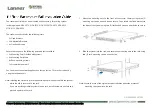
Chapter 1: Configuration
Configuring IP and Ethernet interfaces
Page
1-33
NAT and VPNs
VPN technology provides the benefits of a private network during communication over a public
network. One typical use of a VPN is to connect employees remotely (who are at home or in a different
city), with their corporate network through a public Internet. Any of several VPN implementation
schemes is possible. By design, NAT translates or changes addresses, and thus interferes with a VPN
that is not specifically supported by a given NAT implementation.
With NAT enabled, SM supports L2TP over IPSec (Level 2 Tunneling Protocol over IP Security) VPNs
and PPTP (Point to Point Tunneling Protocol) VPNs. With NAT disabled, SM supports all types of VPNs.
Summary of Contents for PTP 450 Series
Page 51: ...Chapter 1 Configuration Quick link setup Page 1 23...
Page 155: ...Chapter 1 Configuration Configuring security Page 1 127...
Page 163: ...Chapter 1 Configuration Configuring security Page 1 135...
Page 164: ...Chapter 1 Configuration Configuring security Page 1 136...
Page 193: ...Chapter 1 Configuration Configuring radio parameters Page 1 165...
Page 194: ...Chapter 1 Configuration Configuring radio parameters Page 1 166...
Page 195: ...Chapter 1 Configuration Configuring radio parameters Page 1 167...
Page 206: ...Chapter 1 Configuration Configuring radio parameters Page 1 178...
Page 210: ...Chapter 1 Configuration Configuring radio parameters Page 1 182...
Page 636: ...Chapter 5 Troubleshooting Logs Page 5 16 Figure 95 SM Authorization log...
















































